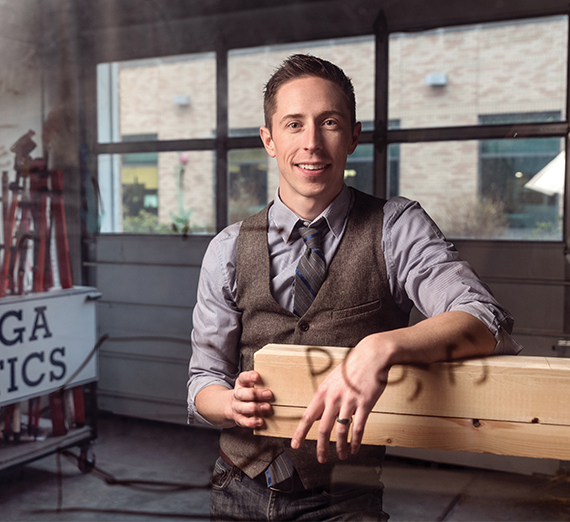Sustainability: Faculty Focus

Treehouses to Timber Tower
On Joshua Schultz’s desk sits a rectangular slab of wood, about two feet long. It doesn’t look like much, but it’s actually the basis for Schultz’s primary research: crosslaminated timber (CLT). These 2x6 pieces of dried wood, glued together in alternating layers to create giant panels, can be used as walls, floors or any other part of a building.
An assistant professor of civil engineering at Gonzaga, Schultz says wood is a perfect material for eco-friendly construction because it is a carbon sink, keeping CO2 from being released into the atmosphere. Using young trees at the peak of their life cycle allows for the maximum amount of carbon to be sequestered, making it an attractive option for promoting sustainability. Combined with other building innovations, CLT can also be incredibly strong – a cross-laminated timber parking garage has been constructed in Portland.
Schultz grew up building treehouses in rural Wisconsin, which led him to want to be an architect, and later, an engineer. After receiving a degree from another Jesuit institution – Marquette University – he worked on the Timber Tower Project for an engineering firm in Chicago, translating his treehouse expertise to real-world construction projects.
While working on the Timber Tower, Schultz began rethinking how wood can be used in construction. A typical high-density, multistory building involves a lot of steel and concrete, which produce significant CO2 emissions. Cement used to make concrete accounts for 5-8 percent of global emissions, so turning to wood has huge sustainability benefits.
Schultz says he’s excited by new technology that makes wood products a viable replacement for nonsustainable materials. “We’re rediscovering a very old material and amping it up,” he says. “Wood is something most everyone appreciates.”
He adds: “Spokane and the Pacific Northwest are uniquely poised in the middle of all this timber. So the challenge is using that to be a positive impact on the environment.”
Keeping Emissions on Track for Spokane
A team of environmental studies and engineering students has found an engaging client for senior design projects: the city of Spokane. Alex Maxwell (’09), assistant professor of civil engineering, oversees the work of seven students conducting a greenhouse gas (GHG) emissions inventory for the city.
Two projects track municipal operations and community-scale emissions, covering everything from transportation and agriculture to industry. The students take different types of emissions measurements and convert them into carbon dioxide equivalents (CO2e), which combine the different types of emissions from each source and convert them into CO2e, making them easy to compare and contrast.
Maxwell believes the inventory is great real-world work for students. They use industry standards to calculate GHG emissions and present information to city representatives. “Beyond the practical aspect, they are learning how to be engaged citizens and what it’s like to work with a local municipality,” Maxwell says.
Local ordinances require the city to calculate and publish GHG emissions created by activities from within the city boundary to help achieve GHG emissions reduction goals.
Cadie Olsen, environmental and sustainability manager for the city, says: “There is a huge benefit in partnering with Gonzaga students. They provide external objectivity and peer-reviewed science, and we can provide them with the deep benefit of working on an experiential project.”
Plus, she says, doing the emissions inventory helps the city to know “we’re using energy resources as efficiently as possible for our citizens,” says Olsen.
Next in "Care for Our Common Home":
LET'S TALK.
Next in "Care for Our Common Home":
LET'S TALK.
- Academics
- Global Impact
- Sustainability
- School of Engineering & Applied Sciences
- Office of Sustainability
- Civil Engineering
- Environmental Studies
- Gonzaga Magazine
